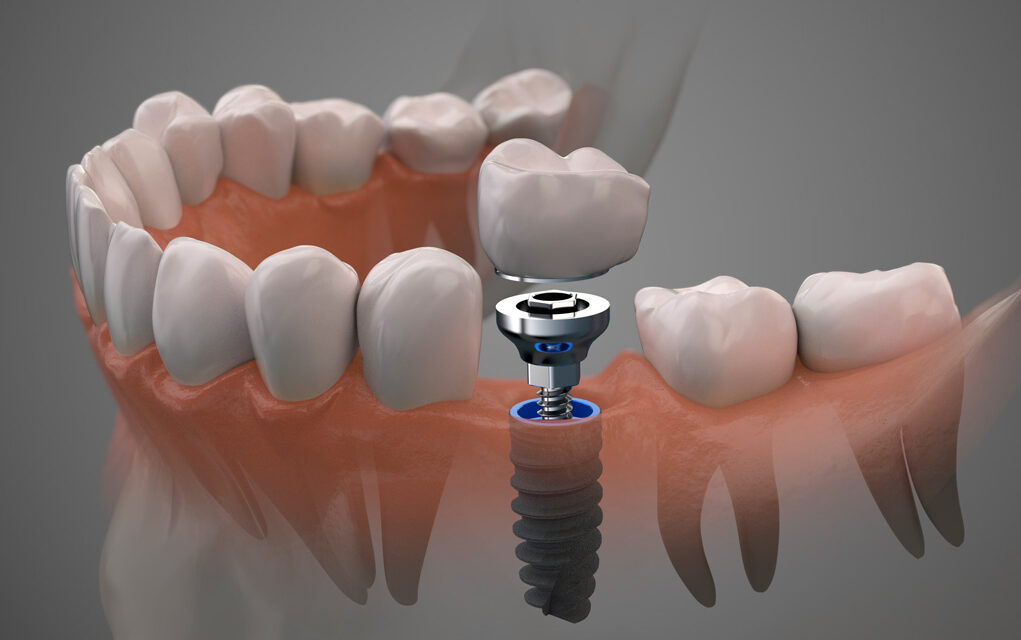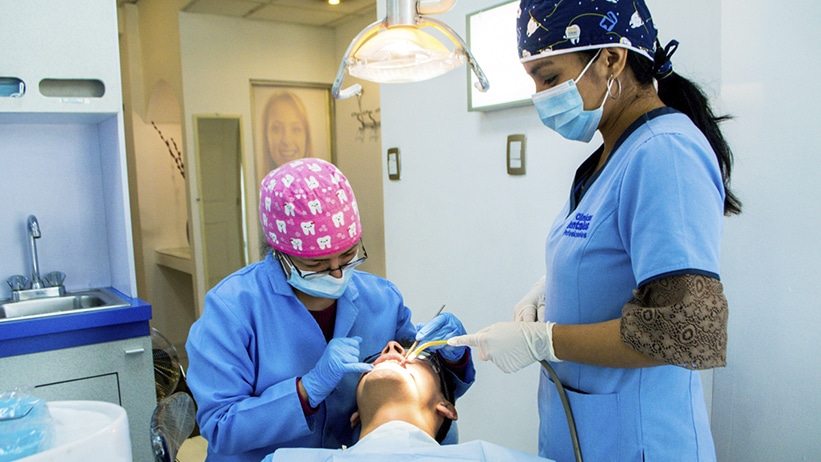Treatments that require more than 2 weeks of traveling or multiple trips to Guatemala
- Implants: 3-month interval between first and second procedure
Dental implants are an option for patients of all ages who have partial or complete tooth loss due to injury, defects, disease or deterioration. It may even be an alternative for teens who have already reached puberty, which is just when the jaw stops growing, which usually occurs around age 16 for women and 18 for men. A dentist specializing in implants will assess the patient’s suitability for the procedure taking into account their medical and dental history.
Implant procedure steps:
1. X-ray examination: the X-ray examination will evaluate the bone and contiguous anatomical structures. If there is enough bone to hold the implant in place, then surgery begins. If not, treatment to augment the existing bone will be initiated in order to ensure the success of the implant procedure.
2. Surgery: once the patient is ready for surgery, a date will be set, and the patient will be given an overview of the procedure. Implant placement usually takes about 30 to 60 minutes. The first stage of surgery is to anesthetize the area and, only when it is sufficiently anesthetized, does the dentist proceed with the surgery.
An implant’s placement requires the penetration of the patient’s bone. To do this, the dentist must penetrate the gum in order to expose the bone. This requires some force and pressure to be exerted. During the penetration phase, the patient will feel the dentist exert pressure, but the effects of local anesthesia will mean no pain will be felt.
Once the bone has been exposed, the holes required for the implant’s placement will be drilled. When this stage is complete, the implant placement will begin. At this stage, the patient will feel a significant amount of pressure, but no pain. The dentist may administer more anesthesia if they feel it’s necessary. The implant is placed, and the bone is then tapped, and the area is sutured.
Depending on the implant and patient, the dentist will decide whether to completely close the gum, or leave the implant cap exposed. In either case, the patient must return for another appointment in order to complete the placement of the implant crown.
Once the suture is in place, the surgery is complete, and ice is usually applied to the area to reduce inflammation. The patient must then follow a set of instructions, which includes both drug treatment and dental hygiene advice.
3. Post-operative advice and instructions:
- Maintain a soft and cold diet for the first 2 days
- Do not rinse for the first 2 days, but rinse with mouth wash after this period
- Take pain medications
- Don’t smoke
- Don’t drink alcohol
- Removal of suture by the dentist
- Clean your teeth with a soft brush, as this is essential in preventing possible infections
4. Removal of suture: after 10 days, an examination is carried out and the suture is removed.
Note: After the implant is put in place, it takes two to three months for the bone to grow and form around the implant which will hold it in place. After this, the impressions required for the replacement tooth can be taken.
5. Measurement and Prosthetic Stage: once the implant is fully attached to the bone, the final stage of the procedure takes place. This involves taking the impressions required for the replacement tooth. The patient’s individual impressions are sent to the laboratory and a bespoke replacement tooth is made based on them. The dentist then places the replacement tooth on the dental implant and completes the whole process.
Any required additional treatments such as a gum or bone graft must be carried out before the implant is placed. The dentist must verify that the patient’s oral cavity is in good condition with no sign of disease and that it can withstand the procedure. If the dentist finds a problem, they will recommend the most appropriate course of treatment for the patient.
Throughout the procedure, digital X-rays and high-speed drills by Bicon or Nobel BioCare are used.
The procedure takes one to four hours depending on the number of implants. As soon as the implant is in place the temporary teeth are then attached. However, each patient is different, and the specialist will adapt to their circumstances.
What are the risks involved with a dental implant procedure?
As with any surgery, dental implant surgery presents some health risks. However, problems are rare, and if they occur, they are generally minor and easily treated. Most commonly, risks include:
- Infection at the implant site
- Injuring or damaging the surrounding structures, such as other teeth or blood vessels
- Nerve injury, which can cause pain, numbness, or tingling in natural teeth, gums, lips, or chin
- Sinus or nasal passage problems can occur when dental implants placed in the upper jaw protrude into the nasal cavity
To help avoid these risks, rest and antibiotics are essential.

- Root canal treatments (RCT) + Crown: The procedure may require two weeks if severe infections are present
Root Canal Treatment (RCT) is a safe and easy procedure that preserves a tooth that should otherwise be extracted. The RCT is performed by an endodontist, who is a dentist specialized in the procedure.
The principal symptom which means a patient should attend immediately, and contact us, is an infection which may be due to a broken tooth or deep decay.
Sometimes travelers require emergency treatment, which requires antibiotics to be given one or two days before the procedure. Root canal treatments are carried out in the dental surgery and can last from forty-five minutes to an hour, depending on whether the tooth has one, two, or three roots. Antibiotics and painkillers may be prescribed after the treatment for an additional day or two, depending on the severity of the condition.
After the root canal treatment is completed, a crown must be applied, or the tooth will dehydrate, weaken and become discolored. All canal treatments require a crown – both procedures are included in our service.
The crown procedure can either be carried out on the same day as root canal treatment or a few days later. This procedure requires two appointments, with one week between each appointment.
Antibiotics may be prescribed, and patients are advised to rest and avoid drinking alcohol after the procedure.
How will the treatment process work while I’m travelling in Guatemala?
- An accurate diagnosis with X-rays is an essential part of determining if the tooth is healthy.
- Anesthesia is used in all cases, regardless of whether the nerve is vital or not.
- The isolation of the tooth to be treated is achieved with a latex rubber dam. Patients allergic to latex should notify the specialist.
- Removal of the decayed tissue and getting access to the nerve. Once the nerve is accessed, the root canals are located in order to begin the root treatment.
- Evaluation of the time required for treatment. In this step, a digital device called an apical locator is used to help the dentist determine the size of the tooth.
- Preparation and cleaning of the root canals with manual and automated files. In the past, this procedure required several appointments, but now it can be generally carried out in a single visit, although there are exceptions.
- While the canals are being filed, they are also irrigated with disinfectants. Irrigation washes out all the debris from the tooth created by the filing process.
- The last step in the procedure is the three-dimensional filling of the root canal. The tooth is filled with a thermoplastic material called gutta percha and sealing cement. This material is fully X-ray and bio-compatible which allows the tooth to be treated in the future.
- Once the endodontics are finished, the porcelain inlay or prosthetic crown are applied to the tooth.
After the procedure, which takes about an hour, the patient should avoid strenuous physical activity for a 24-hour period. Appropriate activities will be arranged so that the patient can continue to enjoy Guatemalan culture and life.


2 Comments
Mark
Thanks for your blog, nice to read. Do not stop.
THGuatemala
Thank you!